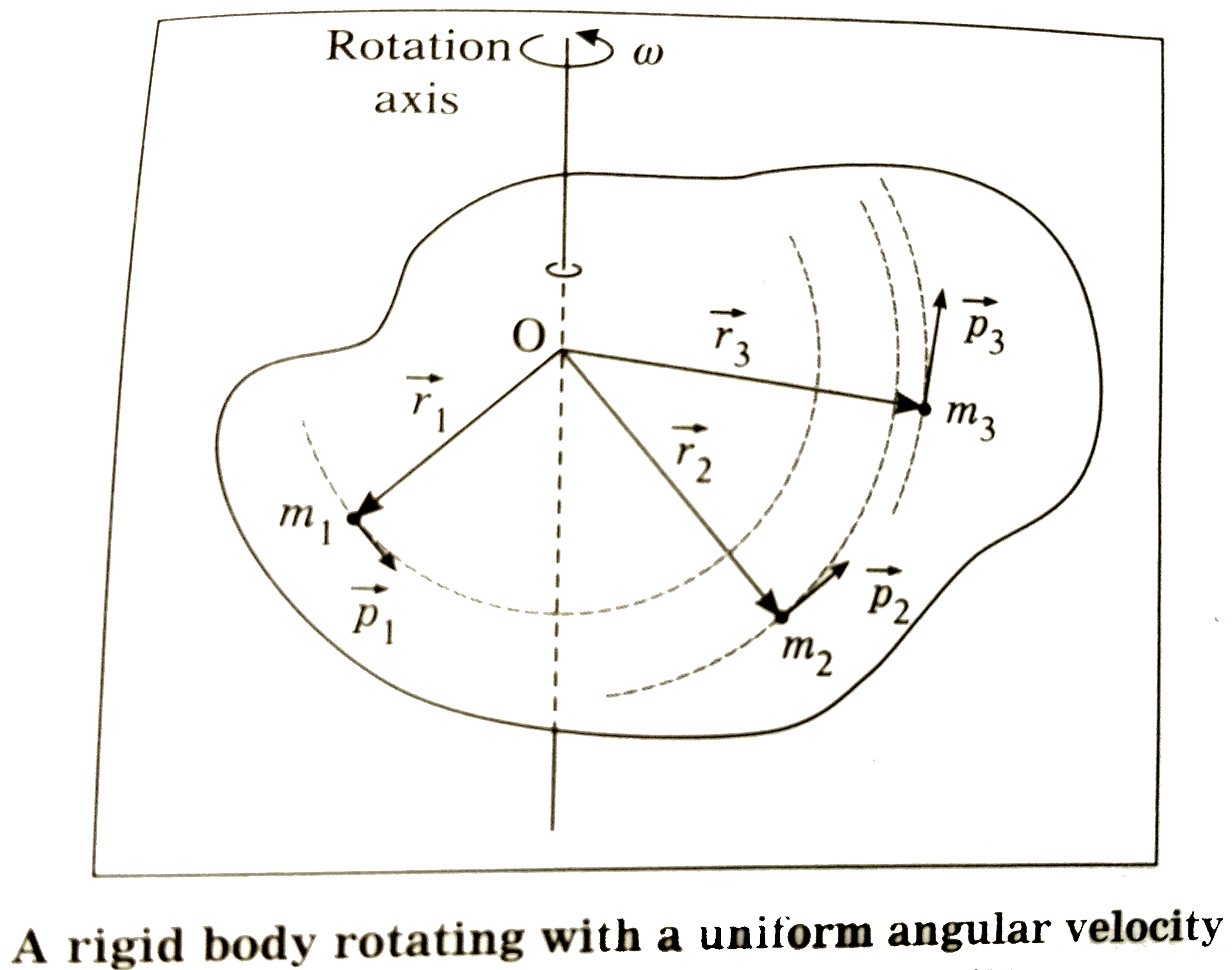Establish a relation between angular momentum and moment of inertia of a rigid body.
Consider a rigid body rotating with a constant velocity →ω about an axis through the point O and perpendicular to the plane of the figure. As the body rotates, all the particles of the body perform uniform circular motion about the axis of rotation with the same angular velocity →ω.Suppose that the body consists of N particles of masses m1,m2,.....mN,situated at distances r1,r2,.....rN, respectively from the axis of rotation.
As the body rotates, the particles of mass m1 revolves along a circle of radius r1, with a linear velocity of magnitude v1=r1ω.

The magnitude of the linear momentum (p1) of the particle is
p1=m1v1=m1r1ω
The angular momentum of the particle about the axis of rotation is by definition,
→L1=→r1×→p1
∴L1=r1p1sinθ, where θ is the smaller angle between →r1 and →p1.
In this case, θ=90∘ ∴sinθ=1
∴L1=r1p1=r1m1r1ω=m1r1ω=m1r21ω
Similarly the angular momentum (L2) of the particle of mass m2 is m2r22ω, that of the particle of mass m3 is m3r23ω, etc.The angular momentum of the body about the given axis is
L=L1+L2+........+LN
=m1r21ω+m2r22ω+.....mNr2Nω
=(m1r21+m2R22+.....+MNr2N)ω
=(NΣi=1mir2i)ω
∴L=Iω, where I=NΣi=1mir2i=moment of inertia of the body about the given axis. In vector form,
→L=I→ω
Thus, angular momentum=moment of inertia×angular velocity.
Topper's Solved these Questions
- DERIVATIONS-IBOOK - NAVNEET PUBLICATION - MAHARASHTRA BOARDCHAPTER - DERIVATIONS-IEXERCISE - Oscillations
5 Videos
- DERIVATIONS-IBOOK - NAVNEET PUBLICATION - MAHARASHTRA BOARDCHAPTER - DERIVATIONS-IEXERCISE - Elasticity
2 Videos
- DERIVATIONS-IBOOK - NAVNEET PUBLICATION - MAHARASHTRA BOARDCHAPTER - DERIVATIONS-IEXERCISE - Gravitation
7 Videos
- DEFINITIONSBOOK - NAVNEET PUBLICATION - MAHARASHTRA BOARDCHAPTER - DEFINITIONSEXERCISE - COMMUNICATION SYSTEMS
3 Videos
- DERIVATIONS-IIBOOK - NAVNEET PUBLICATION - MAHARASHTRA BOARDCHAPTER - DERIVATIONS-IIEXERCISE - Assignments
9 Videos
Similar Questions
(i) Establish the relation between torque and angular acceleration. Hence define moment of inertia.
(ii) Can a body in translatory motion have angular momentum? Explain?
(iii) Extablish the relation between angular moment and moment of inertia for a rigid body. (iv) Why is it more difficult to revolve a stone by tying it to a longer string than by tying it to a shorter string?
(v) State the law of conservation of angular momentum and illustrate it with the example of planetary motion.
(vi) A cat is able to land on its feet after a fall. Why?
View SolutionEstablish a relation between torque and moment of inertia of a rigid body.
View Solution
Knowledge Check
Thye angular momentum and the moment of inertia are respectively
Avector and tensor quantitiesBscalar and vector quantitiesCvector and vector quantitiesDscalar and scalar quantitiesAccording to the principle of conservation of angular momentum, if moment of inertia of a rotating body decreases, then its angular velocity
AdecreasesBincreasesCremains constantDbecomes zeroIf L is the angular momentum and I is the moment of inertia of a rotating body, then L221 represents
Arotational potential energyBtotal energyCrotational kinetic energyDtranslational kinetic energy
Moment Of Inertia Of Rigid Body
View SolutionEstablish a relation between angular momentum and moment of inertia of a rigid body.
View SolutionEstablish the relation between moment of inertia and torque on a rigid body
View SolutionIf L is the angular momentum and I is the moment of inertia of a rotating body, then L22I represents its
View SolutionRelationship between angular momentum L and kinetic energy E of a rigid body in pure rotation is
View Solution
